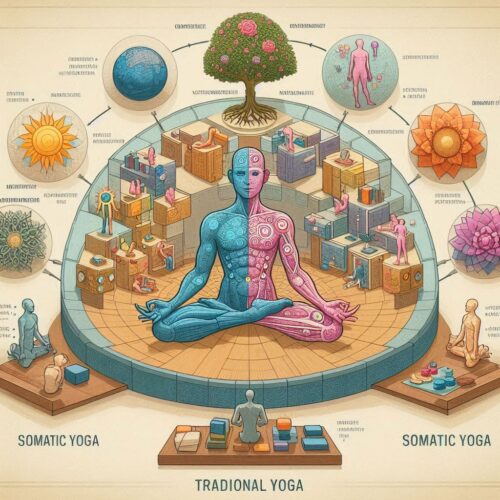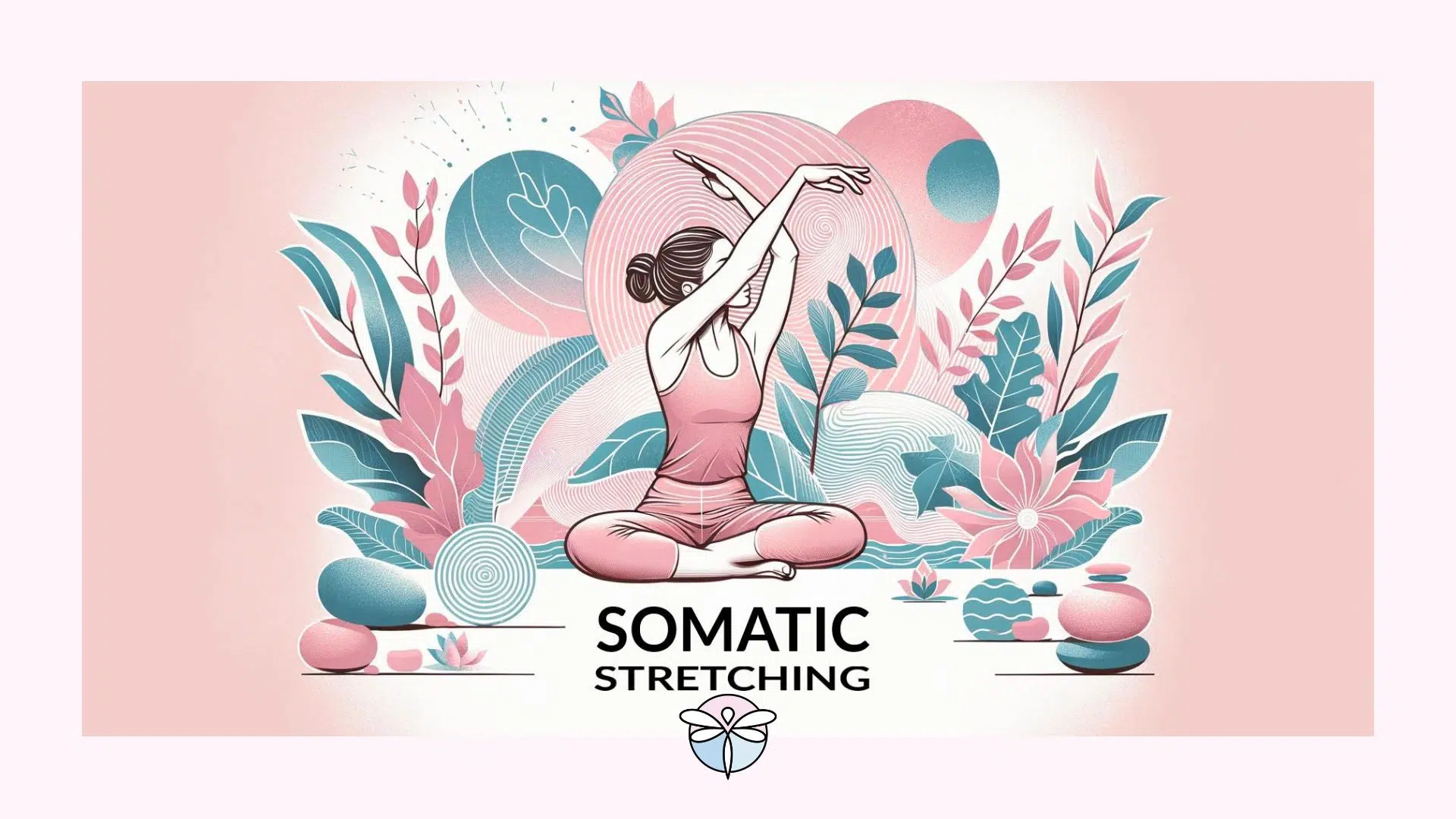Introduction
Somatic Yoga: Unlocking Mind-Body Healing Naturally
In today’s world, stress, chronic pain, and movement issues are common. Traditional yoga focuses on movement and flexibility. But what if true healing comes from within?
Somatic Yoga offers a new way to heal. It goes beyond stretching and exercise. It retrains the nervous system, releases tension, and restores natural movement.
This yoga is different from traditional yoga. It focuses on neuromuscular education, mindfulness, and slow movements. It’s great for those with chronic pain, stress, or mobility issues.
In this guide, we’ll explore Somatic Yoga’s principles and benefits. It’s perfect for beginners, wellness enthusiasts, or those seeking holistic healing. You’ll get valuable insights and expert guidance.
What is Somatic Yoga

Somatic Yoga combines slow movements with breath awareness. It releases muscle tension, improves mobility, and calms the nervous system. Unlike traditional yoga, it focuses on how your body moves.
This practice is based on somatics, developed by Dr. Thomas Hanna. It teaches the body to release tension caused by stress, injury, or poor posture.
Why is Somatic Yoga Ideal for Beginners?
Somatic Yoga is perfect for beginners! It’s a gentle practice that focuses on awareness, controlled movements, and muscle relaxation. It’s accessible to everyone.
- Easy to Learn – It doesn’t require flexibility or strength. You can do simple, mindful movements.
- No Special Equipment Needed – Start with just a yoga mat or a comfortable surface.
- Relieves Tension and Pain – It’s great for stiffness, chronic pain, or poor posture. It helps the body re-learn proper movement.
- Improves Body Awareness – It helps beginners tune into their body’s sensations. This reduces stress and improves movement efficiency.
- Safe and non-Strenuous—It’s perfect for seniors, injury recovery, or anyone looking for a low-impact practice.
Best Way to Start Somatic Yoga as a Beginner
Find a quiet space to practice.
- Focus on slow, mindful movements rather than forcing stretches.
- Start with basic exercises like Arch & Flatten, Pelvic Clock, and Side Bend Release.
- Follow guided videos or online classes to learn proper techniques.
If you’re a beginner looking for a gentle yet powerful yoga, Somatic Yoga is a great choice! Want to try some beginner-friendly exercises?
Benefits of Somatic Yoga
1. Relieves Chronic Pain and Tension
By retraining your nervous system, Somatic Yoga helps release tight muscles. It corrects movement patterns that cause pain in the neck, shoulders, lower back, and hips.
2. Reduces Stress and Anxiety
Somatic movements activate the parasympathetic nervous system. This promotes relaxation and reduces stress-related tension in the body.
3. Improves Mobility and Flexibility
Unlike passive stretching, Somatic Yoga increases flexibility. It re-educates the muscles to move efficiently. This makes it a great option for beginners or those recovering from injuries.
4. Enhances Body Awareness and Posture
Regular practice improves proprioception (body awareness). This helps you move with ease and reduces the risk of injuries.
5. Supports Weight Loss & Metabolism
While not a high-intensity workout, Somatic Yoga reduces stress (a major factor in weight gain). It improves posture and increases mindful movement. All of these support long-term weight management.
How to Start Somatic Yoga at Homee
Starting Somatic Yoga is simple. You don’t need any special equipment. Just a quiet space and a willingness to explore your body’s movements.
Step 1: Create a Calm Practice Space
Find a comfortable place where you can move freely. Use a yoga mat or practice on a soft surface.
Step 2: Focus on Slow, Intentional Movements
Somatic Yoga isn’t about pushing your limits. Move slowly and mindfully. Pay attention to how your muscles feel.
Step 3: Practice Breathing and Body Awareness
Breathwork is an essential part of Somatic Yoga. Deep, slow breathing helps activate the relaxation response. It enhances movement efficiency.
Step 4: Start with Beginner-Friendly Exercises
Begin with a few simple exercises (see below) and gradually build your routine..
Best Somatic Yoga Exercises for Beginners
Here are three simple Somatic Yoga exercises you can try at home:
1. Arch & Flatten (Relieves Lower Back Tension)
How to Do It:
- Lie on your back with knees bent and feet flat on the floor.
- Inhale, gently arch your lower back by tilting your pelvis forward.
- Exhale, flatten your back against the floor by tilting your pelvis backward.
- Repeat slowly for 6–8 reps.
2. Pelvic Clock Exercise (Improves Hip Mobility)
How to Do It:
- Lie on your back with knees bent
- Imagine a clock on your pelvis.
- Slowly tilt your pelvis towards 12 o’clock (backward) and 6 o’clock (forward).
- Then move side to side (3 o’clock and 9 o’clock).
- Repeat 6–8 times, moving in a circular motion.
3. Side Bend Release (Loosens the Spine and Ribs)
How to Do It:
- Sit comfortably or lie down on your side.
- Slowly reach one arm overhead while tilting your torso to the side.
- Hold for a few breaths and return to the starting position
- Repeat 5–6 times on each side
Common Questions About Somatic Yoga
1. Can You Do Somatic Yoga by Yourself?
Yes! Unlike some therapies that require a professional, Somatic Yoga is designed for self-practice. Start with guided videos or tutorials, then develop your own intuitive practice..
2. Is Somatic Yoga Good for Weight Loss?
While not a high-calorie-burning exercise, Somatic Yoga helps regulate stress hormones, improves posture, and encourages mindful eating, all of which support healthy weight loss.
3. How Often Should You Practice Somatic Yoga?
Even 10–15 minutes a day can have significant benefits. For deeper results, aim for 3–5 sessions per week.
Somatic Yoga vs. Traditional Yoga: A Comparative Analysis
| Aspect | Somatic Yoga | Traditional Yoga |
| Approach | Focuses on neuromuscular re-education, releasing muscle tension, and restoring natural movement patterns. | Emphasizes flexibility, strength, and endurance through structured postures (asanas). |
| Movement Style | Slow, internalized movements aimed at retraining the nervous system. | Static poses and sequences held for a period to improve flexibility and strength. |
| Structure | Less rigid, with a fluid and intuitive movement practice. | Follows fixed postures and sequences like Hatha, Vinyasa, or Ashtanga yoga. |
| Goal | Helps in pain relief, stress reduction, and body awareness through mindful movement. | Aims for physical fitness, spiritual growth, and mental focus through breath control and posture. |
| Mind-Body Connection | Strong focus on somatic awareness (feeling movement from within) to release chronic tension. | Encourages mindfulness and breath awareness to deepen the pose. |
| Breathing Techniques | Integrated naturally into movements to facilitate muscle relaxation. | Uses specific pranayama (breathing exercises) for energy control. |
| Effect on Nervous System | Directly retrains the autonomic nervous system, helping to release stress and tension patterns. | Promotes relaxation through breath control and meditation but does not specifically retrain movement patterns. |
| Suitability for Beginners | Highly accessible; ideal for those with chronic pain, mobility issues, or stress. | Some styles can be physically demanding, requiring flexibility and strength. |
| Healing Benefits | Helps with chronic pain, muscle stiffness, posture correction, and nervous system regulation. | Supports flexibility, strength, cardiovascular health, and mental clarity. |
| Why Some Prefer Somatic Yoga | – Ideal for people with pain, injuries, or stiffness. – No need for flexibility or strength. – More intuitive and personalized. | – Great for those looking for spiritual connection. – Helps improve overall fitness and flexibility. – Follows structured practices with clear guidelines. |
Which One Is Right for You?
If you seek gentle healing, nervous system relaxation, and pain relief, Somatic Yoga is a better choice.
If your goal is physical fitness, flexibility, and traditional yoga philosophy, Traditional Yoga may be the right fit.
Many people combine both for a balanced practice!
Who Should Avoid or Modify Somatic Yoga?
Somatic Yoga is generally safe for most people, but caution is advised in certain situations. It’s a gentle and therapeutic practice. However, some individuals should consult a doctor or physical therapist before starting.
People with Acute Injuries or Recent Surgeries
If you’ve had recent surgery, fractures, or severe muscle strains, avoid Somatic Yoga until you’re cleared by a medical professional.
Gentle movement may help recovery, but improper technique could worsen the injury.
Individuals with Severe Mobility Issues
Those who struggle with balance, paralysis, or neurological disorders should seek guided support.
A trained instructor or therapist can modify movements to suit individual needs.
People with Certain Chronic Conditions (Without Medical Approval)
If you have severe osteoporosis, herniated discs, or advanced arthritis, some movements may cause discomfort.
Modifications or alternative exercises might be needed.
Those Experiencing Unmanaged Chronic Pain
If pain worsens during movement, stop and consult a doctor before continuing.
Somatic Yoga can help with pain relief, but improper execution might aggravate symptoms.
Anyone with Dizziness or Blood Pressure Issues
If you experience vertigo, low blood pressure, or dizziness, avoid positions that require sudden movement or lying down for extended periods.
Pregnant Women (Without Proper Guidance)
While some Somatic Yoga movements can be beneficial during pregnancy, certain positions may not be safe.
Always check with a prenatal yoga instructor or healthcare provider before practicing.
What to Do If You Have Any of These Conditions?
✅ Consult a doctor or physical therapist before starting.
✅ Work with a certified Somatic Yoga instructor for modifications.
✅ Listen to your body—if any movement causes pain, stop immediately.
Recommended Somatic Yoga Practice Schedule for Beginners
For beginners, practicing Somatic Yoga 3 to 5 times a week is ideal. Even 10–15 minutes a day can provide noticeable benefits. The key is consistency and mindfulness, rather than intensity or duration.
3–5 Days per Week (Best for Results)
- Helps release chronic tension and rewire movement patterns faster.
- Encourages deep relaxation and improves posture over time.
Daily (10–15 Minutes for Maintenance)
- Great for stress relief and maintaining flexibility, mobility, and body awareness.
- Perfect as a morning or bedtime routine.
1–2 Times per Week (Slow Progress, But Still Beneficial)
- Good if you’re incorporating Somatic Yoga with other exercises.
- Slower progress but can still help with pain relief and relaxation.
Best Time to Practice Somatic Yoga
✅ Morning – Helps wake up the body, relieve stiffness, and start the day with calmness.
✅ Before Bed – Promotes relaxation, reduces stress, and improves sleep quality.
✅ After Workouts – A great cool-down routine to release tension and improve recovery.
Conclusion & Call to Action
Somatic Yoga is a gentle yet powerful way to release tension, improve mobility, and restore your body’s natural ease of movement. By practicing mindful, slow movements, you can reduce stress, relieve chronic pain, and enhance overall well-being—all without intense stretching or forceful poses.
🌿 Ready to experience the benefits for yourself? 🌿 Start with a simple movement: Arch & Flatten 🧘♀️
1️⃣ Lie down on your back with your knees bent.
2️⃣ Slowly arch your lower back as you inhale.
3️⃣ Gently flatten it against the floor as you exhale.
4️⃣ Repeat 5-10 times with full awareness of each movement.
✨ Give it a try and notice how your body feels! Drop a “DONE” in the comments once you’ve tried it, or message me for a simple Somatic Yoga guide to help you get started! 💙
#SomaticYoga #GentleHealing #MindBodyAwareness #StartYourJourney



